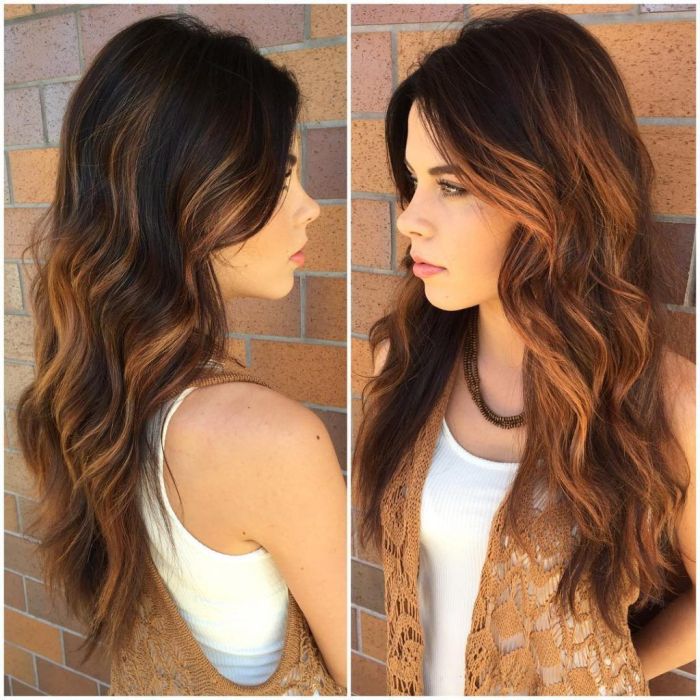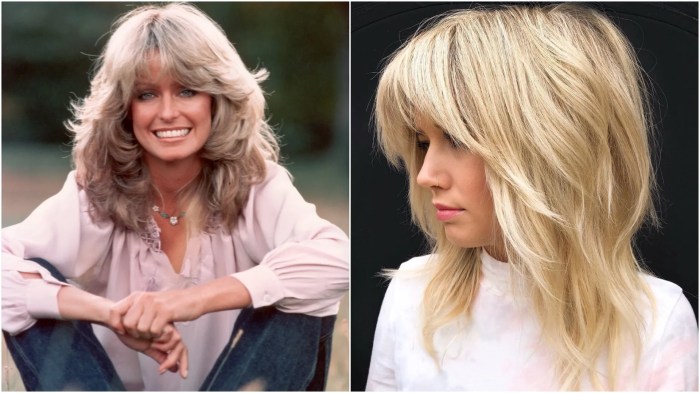Long Hair 70s Hairstyles A Retro Look
Iconic 70s Long Hairstyles: Long Hair 70s Hairstyles
Long hair 70s hairstyles – The 1970s witnessed a revolution in long hairstyles, reflecting the era’s social and cultural shifts. From the free-flowing locks of the hippie movement to the glamorous waves of disco, long hair became a powerful symbol of self-expression. This section explores the most popular styles, the celebrities who embraced them, and the cultural forces that shaped their prominence.
Popular 70s Long Hairstyles and Their Defining Characteristics
Several distinct long hairstyles defined the 1970s, each with unique characteristics reflecting the decade’s diverse aesthetics. These styles ranged from the effortlessly bohemian to the meticulously styled looks of the disco era. The common thread was length and volume, often achieved through layering and teasing techniques.
Examples of Celebrities and Their Iconic 70s Hairstyles
Many iconic celebrities helped popularize these looks, solidifying their place in fashion history. Their influence extended beyond the silver screen, shaping the hairstyles adopted by everyday people.
| Celebrity Name | Hairstyle Name | Description | Image Description |
|---|---|---|---|
| Farrah Fawcett | The Farrah Flip | Long, layered, and feathered hairstyle with a signature flipped-out ends. Characterized by its volume and movement. | A photograph would show shoulder-length hair with distinct layers, creating a feathered effect, with the ends flipped outward. The hair is styled with significant volume, especially around the face. |
| Jane Fonda | Long, Straight Layers | Long, straight hair with subtle layers that added movement and avoided a flat, lifeless look. Often parted in the middle. | An image would depict straight, shoulder-length to below-shoulder-length hair with a center part. The layers are subtle, adding subtle volume and a gentle wave to the overall look. |
| Cher | Long, Wavy Shag | Long, wavy hair with a shaggy, unkempt texture. This style incorporated layers and often featured bangs or a fringe. | A photo would reveal long, wavy hair with uneven lengths and a slightly disheveled appearance. Layers add texture and movement, and a fringe might frame the face. |
| Stevie Nicks | Long, Flowing Waves | Long, flowing waves, often incorporating braids or other decorative elements. The style emphasized natural texture and a romantic aesthetic. | The image would show very long, wavy hair with a natural, uncontrived look. The hair might be parted to one side, and braids or other embellishments could be incorporated. |
Cultural Influences on 70s Long Hairstyles, Long hair 70s hairstyles
The hairstyles of the 1970s were heavily influenced by the social and cultural movements of the time. The counter-culture movement, with its emphasis on natural beauty and self-expression, greatly impacted the popularity of long, flowing hair. The rise of feminism also contributed to the acceptance of a wider range of hairstyles, reflecting individual preferences rather than rigid societal expectations. Disco culture, with its emphasis on glamour and shine, led to more structured and styled long hairstyles.
Hair Care and Styling Techniques of the Era
Achieving and maintaining the iconic 70s hairstyles required specific hair care products and styling techniques. This section explores the tools and methods used to create the voluminous, layered looks that defined the decade.
Hair Care Products and Tools of the 1970s
The 1970s saw the rise of various hair care products designed to create and maintain voluminous styles. Popular products included volumizing mousses, setting lotions, and hairsprays, often with strong holds. Large-barrel curling irons and hot rollers were essential tools for creating waves and curls. Teasing combs were also heavily used to create volume at the roots.
Styling Techniques for Achieving Popular 70s Long Hairstyles
Layering, feathering, and volumizing were key techniques used to create the signature 70s looks. Layering added movement and texture, while feathering created a softer, more delicate look. Backcombing or teasing was essential for achieving the voluminous styles popular at the time.
Comparison of 70s and Modern Hair Care Routines
Modern hair care routines differ significantly from those of the 1970s. While 70s styles often relied on harsh chemicals and heat styling, modern practices emphasize gentler approaches, with a greater focus on hair health and natural textures. Modern products are also formulated to be less damaging and more conditioning.
Variations in Long 70s Hairstyles Based on Hair Texture
The versatility of 70s long hairstyles allowed for adaptation to different hair textures. Straight, wavy, and curly hair each lent itself to unique styles, reflecting the individuality of the era.
Hairstyles for Straight, Wavy, and Curly Hair

Source: inflexa.com
Long hair in the 70s offered a variety of iconic styles, from flowing layers to voluminous curls. Achieving that signature 70s look, however, often requires careful consideration of hair texture; for those with fine hair, achieving body and volume can be challenging. Fortunately, there are many techniques and styles available, as detailed on this helpful resource for ladies hairstyles for fine hair , which can then be adapted to create stunning 70s-inspired looks.
Mastering these techniques can unlock the secret to achieving those enviable, full-bodied 70s hairstyles even with fine hair.
Straight hair could be styled into sleek, layered cuts or given volume with teasing and the use of volumizing products. Wavy hair was easily styled into flowing waves and curls, often enhanced with rollers or curling irons. Curly hair often embraced its natural texture, with styles emphasizing volume and shape.
Step-by-Step Guide for Achieving a Specific 70s Long Hairstyle
This guide provides a step-by-step process for achieving a classic 70s look for each hair type. Note that these are general guidelines and adjustments may be needed depending on individual hair characteristics.
Straight Hair: Sleek, Layered Look
- Wash and condition hair.
- Apply a smoothing serum or heat protectant.
- Blow-dry hair straight, using a paddle brush.
- Use a flat iron to straighten any remaining waves or curls.
- Apply a light-hold hairspray for shine and hold.
Wavy Hair: Flowing Waves
- Wash and condition hair.
- Apply a curl-enhancing mousse or cream.
- Use large rollers or a curling iron to create loose waves.
- Once cooled, gently finger-comb the waves.
- Apply a light-hold hairspray for hold and shine.
Curly Hair: Voluminous Curls
- Wash and condition hair with moisturizing products.
- Apply a curl-defining cream or gel.
- Allow hair to air dry or diffuse with a low heat setting.
- Once dry, gently separate curls with your fingers.
- Apply a light-hold hairspray for definition and hold.
The Influence of Fashion and Subculture on 70s Long Hair
The long hairstyles of the 70s were intrinsically linked to the fashion trends and subcultures of the era. This section examines the relationship between these elements and how hairstyles reflected the social and political climate.
Connection Between 70s Fashion and Hairstyles
Bohemian fashion, with its emphasis on flowing fabrics and natural textures, complemented the long, wavy hairstyles popular during the early 70s. Disco fashion, with its focus on glamour and shine, influenced the adoption of more structured and styled long hairstyles later in the decade.
Subcultures and Their Unique Long Hairstyles
Hippies often sported long, unkempt hair, reflecting their rejection of mainstream culture. Rockers embraced long hair as a symbol of rebellion, often styling it with layers and volume. These styles represented the different ideologies and values of these groups.
Reflection of Social and Political Changes

Source: glamour.com
The long hair of the 70s reflected the social and political changes occurring at the time. It was a symbol of freedom, self-expression, and rebellion against traditional norms. The different styles represented the diversity of thought and the evolving social landscape.
Modern Interpretations of 70s Long Hairstyles
The enduring appeal of 70s hairstyles is evident in their continued presence in modern fashion. This section explores how these classic looks have been reinterpreted and adapted for contemporary tastes.
Modern Takes on Classic 70s Styles
Modern interpretations often incorporate elements of classic 70s styles while updating them with contemporary techniques and aesthetics. For example, the Farrah Flip might be reimagined with a more modern, less voluminous approach, incorporating subtle layers and a more relaxed texture.
Comparison of Original and Contemporary Styles
While modern versions maintain the essence of 70s styles, they often differ in terms of texture, volume, and overall finish. Modern styling techniques and products allow for a more controlled and polished look compared to the sometimes more unkempt styles of the original era.
Modern Interpretation of a Classic 70s Hairstyle: The Shag
A modern take on the 70s shag would retain the signature layered, textured look, but with a more refined approach. The layers would be less choppy and more subtly blended, creating a softer, more polished silhouette. The overall texture would be less disheveled, with a focus on creating movement and volume without appearing overly messy. The bangs, if incorporated, would be styled with a more contemporary feel, perhaps slightly longer and swept to the side.
Quick FAQs
How did 70s hairstyles differ for different ethnicities?
While the overall trends influenced many, ethnic variations existed. African American women, for example, often incorporated afros, braids, and other styles reflecting their cultural heritage, adapting the broader 70s trends to their own hair textures.
What were some common hair problems faced by people with long hair in the 70s?
Common problems included dryness due to over-styling and harsh products, as well as damage from heat styling tools. The lack of readily available moisturizing products also contributed to these issues.
Did men also sport long hair in the 70s?
Yes, long hair was prevalent among men as well, often associated with counter-culture movements and rock and roll styles. Think of musicians like David Bowie or Mick Jagger.












